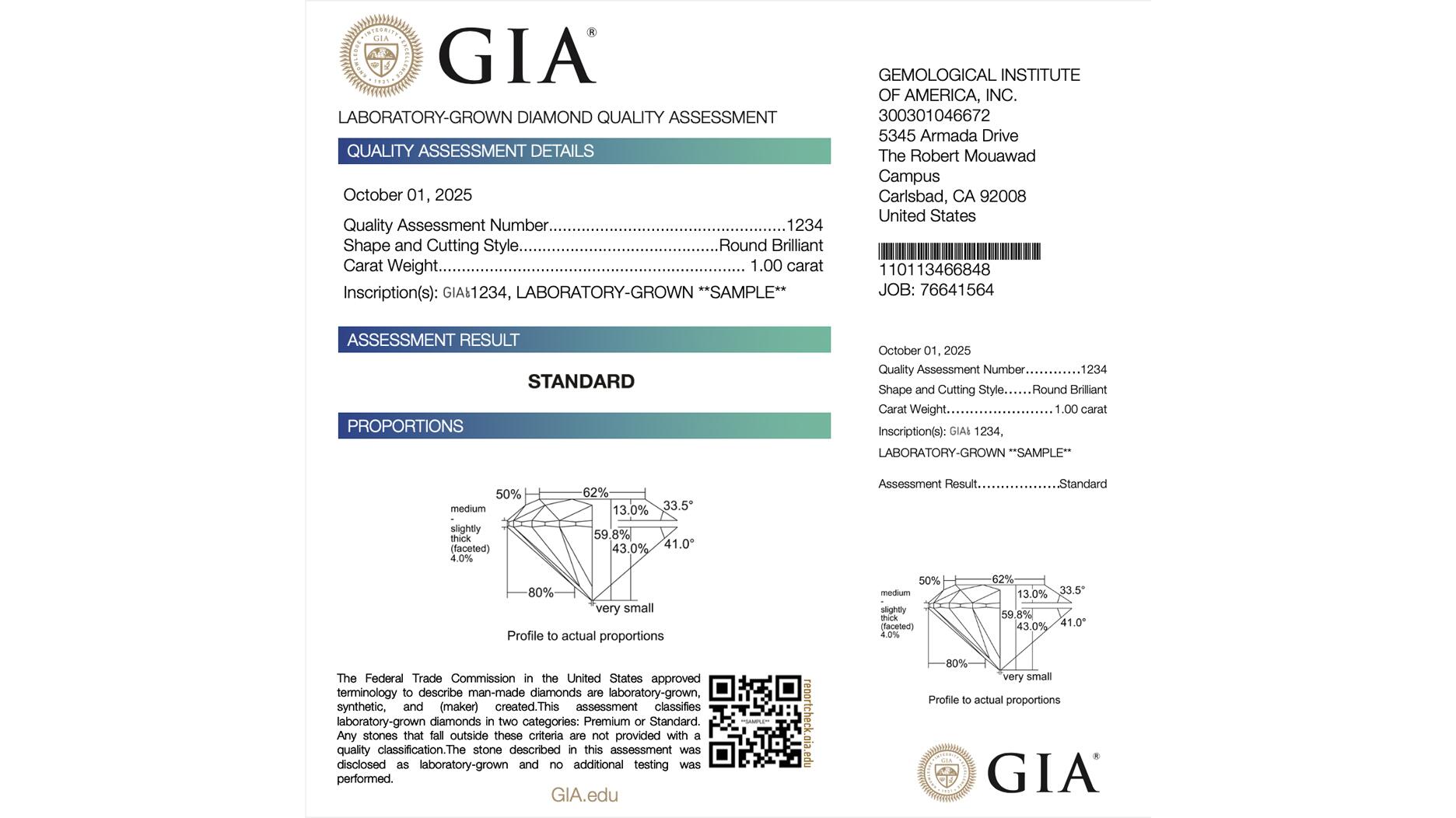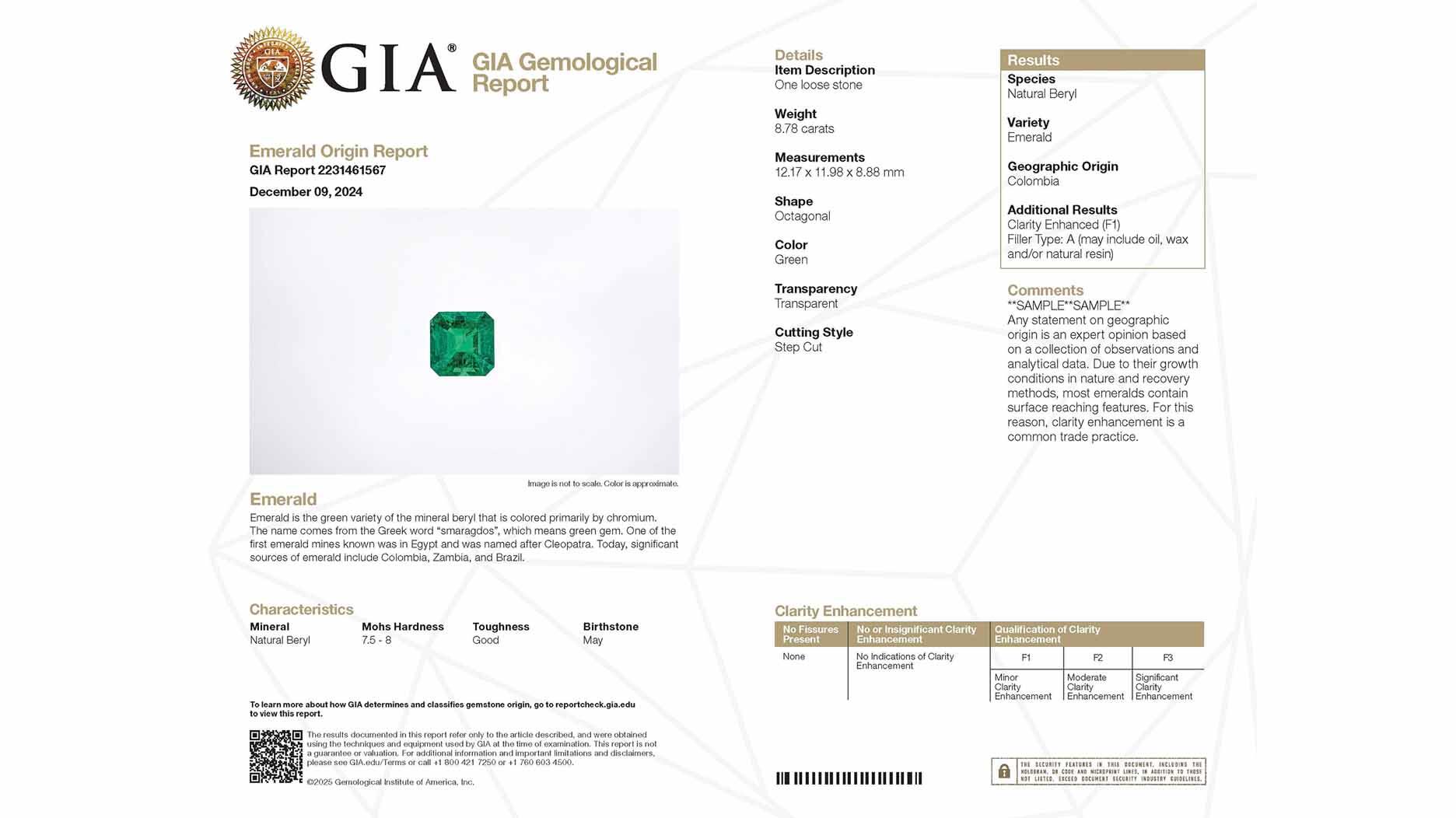GIA’s New ‘Quality Assessment’ for Lab-Grown Diamonds Is Coming
It will classify lab-grown stones into one of two categories, “premium” or “standard,” in lieu of giving specific color and clarity grades.

Beginning Oct. 1, the lab will replace its digital-only lab-grown diamond grading reports, which evaluate the stones using the same color and clarity scale applied to natural diamonds, with a printed and much more general document called the GIA Laboratory-Grown Diamond Quality Assessment.
The assessment will be available only for lab-grown diamonds of a certain size (0.15 carats and up) and quality, with each stone being classified as either “premium” or “standard.”
In its press release announcing the pending change, GIA outlined the criteria for the two classifications.
To be deemed “premium,” lab-grown diamonds must be: D color; VVS clarity or higher; have “excellent” polish and symmetry; and, for round brilliant-cut diamonds, a cut grade of “excellent.”
Lab-grown diamonds that meet any combination of the “premium” criteria described above and the following minimum criteria will be classified as “standard.”
Those minimum criteria are: E to J color; VS clarity; “very good” polish; “very good” symmetry (or “good” for fancy shapes); and, for round brilliants only, a “very good” cut grade.
Lab-grown diamonds that do not meet the minimum criteria will not receive an assessment, GIA said.
The cost for the GIA Laboratory-Grown Diamond Quality Assessment will be $15/carat, with a minimum charge of $15.
That is half what the lab is currently charging for its more basic Laboratory-Grown Diamond Report Dossier for the smallest diamonds, 0.15-0.22 carats, according to the current fee schedule for lab-grown diamond grading reports on the GIA website.
The cost for a regular Laboratory Grown-Diamond Report starts at $60 for 0.15- to 0.22-carat stones.
Anyone who submits a diamond that does not qualify as “premium” or “standard” will still have to pay $5.
GIA will inscribe the girdle of each stone submitted and ultimately assessed with the words “Laboratory-Grown,” as well as the quality assessment number.
Tuesday’s news follows the announcement GIA made in early June during the Las Vegas jewelry shows about its intention to revert to more general terminology for lab-grown diamonds.
The updated language is actually less specific than what the lab used when it first started grading lab-grown diamonds in 2006.
Back then, the stones received a Synthetic Diamond Grading Report and were classified as either “colorless” (D, E, F) or “near colorless” (G, H, I), and assigned one of four clarity grades: VVS, VS, SI, or I.
In April 2019, following the release of the Federal Trade Commission’s revised Jewelry Guides, GIA announced it was changing the report’s name from the GIA Synthetic Diamond Grading Report to the GIA Laboratory-Grown Diamond Report.
The lab also began including the standard color, clarity, and cut grading scales used for natural diamonds on the reports, though it continued to grade lab-grown diamonds the same way, noting the scales were included for reference purposes only.
That changed in August 2020 when GIA announced that it would start using the same specific color and clarity grades for both natural and lab-grown diamonds, citing the “growing acceptance” of the product.
Five years later, the lab is altering its approach to lab-grown diamonds again, with current President and CEO Pritesh Patel echoing what Tom Moses told National Jeweler in a 2016 interview.
“Using descriptive terms for the quality of laboratory-grown diamonds is appropriate, as most fall into a very narrow range of color and clarity,” Patel said in Tuesday’s release.
“Because of that, GIA will no longer use the nomenclature created for natural diamonds to describe what is a manufactured product.”
The Latest

Set in a Tiffany & Co. necklace, it sold for $4.2 million, the highest price and price per carat paid for a Paraíba tourmaline at auction.

The jeweler’s “Deep Freeze” display showcases its iconic jewelry designs frozen in a vintage icebox.

Take luxury gifting to new heights this holiday season with the jeweler’s showstopping 12-carat sphene ring.

How Jewelers of America’s 20 Under 40 are leading to ensure a brighter future for the jewelry industry.

This year's theme is “Unveiling the Depths of the Ocean.”


In its annual report, Pinterest noted an increase in searches for brooches, heirloom jewelry, and ‘80s luxury.

The 111-year-old retailer celebrated the opening of its new location in Salem, New Hampshire, which is its third store in the state.

Roseco’s 704-page catalog showcases new lab-grown diamonds, findings, tools & more—available in print or interactive digital editions.

The new catalog features its most popular chains as well as new styles.

The filmmaker’s personal F.P. Journe “FFC” prototype was the star of Phillips’ recent record-setting watch auction in New York.

The new location in the Design District pays homage to Miami’s Art Deco heritage and its connection to the ocean.

Inflations, tariffs, and politics—including the government shutdown—were among consumers’ top concerns last month.

“Longtime favorite” presenters, as well as first-time speakers, will lead talks and workshops at the annual event in Tucson next year.

Silas Smith of Meridian Metalworks won the challenge with his pendant that blends Australian and American landscapes.

The sale of the 31.68-carat, sunset-hued stone was part of Sotheby’s first series of events and auctions in Abu Dhabi.

Most customers who walk into your store this month have made up their minds. Your job is to validate their choice, Emmanuel Raheb writes.

The collection features characters and motifs from Ukrainian folklore, including an enchanted mirror and a magic egg.

MatrixGold 3.11, the newest version of the jewelry design program, offers more flexibility, precision, and creative control.

The pavilion will be part of the 2026 JA New York Spring show, scheduled for March 15 to 17.

Kadet, a 1994 National Jeweler Retailer Hall of Fame inductee, helped grow the family-owned retailer in the Chicago area and beyond.

Billed as the world’s smallest wearable, Lumia Health’s new smart earrings have a health tracker subtly embedded in the back.

Don’t let those with December birthdays feel blue. Help them celebrate their month with blue zircon, turquoise, and tanzanite.

The new pink sapphire version of the piece dances with its wearer in the brand’s “Icons After Dark” holiday campaign.

A choice that’s generated a lot of commentary, Pantone says “Cloud Dancer” marks a fresh start and encourages relaxation and creativity.

The manufacturer’s holiday campaign features a gift guide filled with trending designs and jewelry that can be personalized.

The man was charged with theft, accused of ingesting the necklace while in a jewelry store in Auckland, New Zealand.

The Florida independent expanded its store from 8,000 to 14,000 square feet, fulfilling the vision of its late co-founder, Jim Dunn.





























